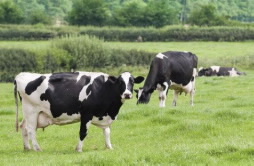EMBARGOED FOR RELEASE | September 01, 2011
Feeding cows natural plant extracts can reduce dairy farm odors and feed costs
Note to journalists: Please report that this research was presented at a meeting of the American Chemical Society.
DENVER, Sept. 1, 2011 — With citizens’ groups seeking government regulation of foul-smelling ammonia emissions from large dairy farms, scientists today reported that adding natural plant extracts to cow feed can reduce levels of the gas by one-third while reducing the need to fortify cow feed with expensive protein supplements. They reported here at the 242nd National Meeting & Exposition of the American Chemical Society (ACS).
J. Mark Powell, Ph.D., described the results of three studies undertaken to determine how adding plant substances called “tannins” to cow feed affects the emission of ammonia from dairy barn floors and farm fields fertilized with mixtures of cow manure and urine.
“For dairy farms, cow urine is the source of the ammonia emission problem,” said Powell, who is with the U.S. Department of Agriculture (USDA) Agricultural Research Service (ARS). “Dairy cows excrete large amounts of urine, about 3.5 gallons daily for each cow. That’s almost 1,300 gallons per year. And there are about 10 million dairy cows in the United States alone. Cows usually are fed a high-protein diet, and they produce various nitrogen compounds when they digest protein. They release the excess nitrogen mainly in their urine, and enzymes convert it into ammonia.”
Media Contact
During the meeting, Aug. 25-Sept. 1, the contacts can be reached at: 303-228-8532
Michael Bernstein
202-872-6042
m_bernstein@acs.org
Michael Woods
202-872-6293
m_woods@acs.org
Ammonia has an acrid, eye-tearing odor and has potential adverse health effects on both cows and humans. Citizens’ groups several months ago petitioned the U.S. Environmental Protection Agency (EPA) to begin regulating ammonia under the Clean Air Act, intensifying the search for practical, inexpensive ways to reduce emissions of the noxious gas. Besides its pungent odor, ammonia adds to air pollution, forming particles that travel long distances and contribute to environmental issues such as smog, acid rain and nutrient pollution.
The ammonia problem originates with the nitrogen-rich protein in cow feed. Cows’ digestive systems are inefficient, and barely one-third of the nitrogen in their feed ends up in milk. The rest exits in urine and feces. The nitrogen in urine is in the form of urea, and enzymes contained in cow manure on the barn floor quickly convert it into ammonia gas.
Tannins apparently reduce urea production by allowing more protein to escape digestion in the stomach and enter the cow’s intestines, where it’s used to produce milk protein.
Powell began investigating tannins in animal feed 20 years ago in West African communities where he lived and worked. Tannin-rich shrubs were grown as windbreaks to reduce soil erosion and to feed livestock. Tannins also are a key part of the diets of cattle, sheep and goats in tropical areas where vegetation tends to be naturally higher in the astringent plant chemicals. However, tannins have attracted relatively little attention elsewhere, Powell said.
He hopes the addition of tannins to animal feed will become much more widespread in light of the findings about their potential for curbing ammonia emissions. The tannin extracts used in the studies are already approved for animal feed and would cost only a few cents a day, he said. Tannins are perhaps best known for their use in tanning leather, and the quebracho and chestnut trees are sources for both leather tanning and cattle feed. Powell said that it may be possible to produce synthetic tannins at a lower cost.
Next on Powell’s agenda is research to determine whether tannins also can reduce emissions of methane gas — a potent greenhouse gas involved in global warming — from cattle production. About 25 percent of methane emissions in the United States are from enteric fermentation (mostly belches) of domestic cattle.
###

extracts to cow feed can reduce smelly ammonia
gas emissions from large dairy farms and cut the
costs of feed.


